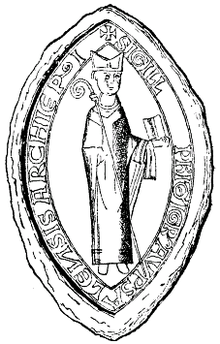Church of Sweden
The Church of Sweden (Swedish: Svenska kyrkan) is an Evangelical Lutheran national church in Sweden. A former state church, headquartered in Uppsala, with 5.9 million members at year end 2018 it is the largest Christian denomination in Sweden.
Church of Sweden | |
|---|---|
| Svenska kyrkan | |
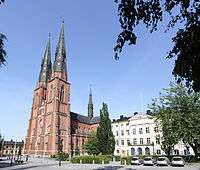 | |
| Classification | Protestant |
| Orientation | Lutheran |
| Polity | Episcopal |
| Primate | Archbishop Antje Jackelén |
| Associations | Lutheran World Federation, World Council of Churches, Conference of European Churches, Porvoo Communion |
| Region | Sweden |
| Headquarters | Uppsala, Sweden |
| Founder | King Gustav I of Sweden |
| Origin | 1536/1593 |
| Separated from | Roman Catholic Church |
| Separations | Evangelical Lutheran Church of Finland (1809) |
| Congregations | 1,360 (2019)[1] |
| Members | 5,817,634 members (56,4 %) (2019)[1] |
| Official website | www |
| Logo | |
It is the largest Lutheran denomination in Europe and the third-largest in the world after the Ethiopian Evangelical Church Mekane Yesus and the Evangelical Lutheran Church in Tanzania.[2] A member of the Porvoo Communion, the Church professes the Lutheran branch of Christianity. It is composed of thirteen dioceses, divided into parishes.[3] It is an open national church which, working with a democratic organisation and through the ministry of the church, covers the whole nation. The Primate of the Church of Sweden is the Archbishop of Uppsala — currently Antje Jackelén, Sweden's first female archbishop. Today, the Church of Sweden is an Evangelical Lutheran church.[4]
It is liturgically and theologically "high church", having retained priests, vestments, and the Mass during the Swedish Reformation. In common with other Evangelical Lutheran churches (particularly in the Nordic and Baltic states), the Church of Sweden maintains the historical episcopate. Some Lutheran churches have congregational polity or modified episcopal polity without Apostolic succession, but the historic episcopate is maintained in Sweden and the other Lutheran nations of the Porvoo Communion.
The Church of Sweden is known today for its liberal position in theological issues, particularly the question of homosexuality. When Eva Brunne was consecrated as Bishop of Stockholm in 2009, she became the first openly lesbian bishop in the world.[5]
Despite a significant yearly loss of members (lately 1-2% annually), its membership of 5,817,634 people accounts for 56.4 % (yearend 2019) of the Swedish population.[1] Until 2000 it held the position of state church. The high membership numbers are because until 1996 all newborn children were made members, unless their parents had actively cancelled their membership.[6] Approximately 2% of the church's members regularly attend Sunday services. According to a Gallup poll conducted in 2009, 17% of the Swedish population considered religion as an important part of their daily life.[7]
Theology
King Gustav I Vasa instigated the Church of Sweden in 1536 during his reign as King of Sweden. This act separated the church from the Roman Catholic Church and its canon law. In 1571, the Swedish Church Ordinance became the first Swedish church order following the Reformation.
The Church of Sweden became Lutheran at the Uppsala Synod in 1593 when it adopted the Augsburg Confession to which most Lutherans adhere. At this synod, it was decided that the church would retain the three original Christian creeds: the Apostles', the Athanasian, and the Nicene.
In 1686, the Riksdag of the Estates adopted the Book of Concord, although only certain parts, labelled Confessio fidei, were considered binding, and the other texts merely explanatory. Confessio dei included the three aforementioned Creeds, the Augsburg Confession and two Uppsala Synod decisions from 1572 and 1593.

During the 19th and 20th centuries, a variety of teachings were officially approved, mostly directed towards ecumenism:
- 1878 development of the Catechism
- the Uppsala Creed of 1909, preparing for Eucharistic communion with the Church of England
- the constitutions of World Council of Churches (WCC)
- the constitutions of Lutheran World Federation (LWF)
- Church of Sweden's official response to the "Lima document"
- a Council of the Bishops Letter in Important Theological Questions
- the 1995 Treaty of Communion with the Philippine Independent Church
In practice, however, the Lutheran creed texts play a minor role, and instead the parishes rely on Lutheran tradition in coexistence with influences from other Christian denominations and diverse ecclesial movements such as Low Church, High Church, Pietism ("Old Church") and Laestadianism, which locally might be strongly established, but which have little nationwide influence.
During the 20th century the Church of Sweden oriented itself strongly towards liberal Christianity and human rights. In 1957, the church assembly rejected a proposal for ordination of women, but then the Riksdag changed the law in spring 1958 and forced the church assembly to accept the new law in autumn 1958. Since 1960, women have been ordained as priests, and since 1994, men who oppose collaboration with women priests have not been allowed ordination. A proposal to perform same-sex weddings was approved on October 22, 2009 by 176 of 249 voting members of the Church of Sweden Synod.[8]
In 2000 the Church of Sweden ceased to be a state church, but there remains a strong tradition of community connection with churches, particularly in relation to rites of passage, with many infants baptized and teenagers confirmed (currently 40% of all 14 year olds[9]) for families without formal church membership.
History
Middle Ages
| Year | Population | Church members | Percentage | % change (avg.) |
|---|---|---|---|---|
| 1972 | 8,146,000 | 7,754,784 | 95.2% | |
| 1975 | 8,208,000 | 7,770,881 | 94.7% | 0.2% |
| 1980 | 8,278,000 | 7,690,636 | 92.9% | 0.3% |
| 1985 | 8,358,000 | 7,629,763 | 91.5% | 0.3% |
| 1990 | 8,573,000 | 7,630,350 | 89.0% | 0.5% |
| 1995 | 8,837,000 | 7,601,194 | 86.0% | 0.6% |
| 2000 | 8,880,000 | 7,360,825 | 82.9% | 0.6% |
| 2005 | 9,048,000 | 6,967,498 | 77.0% | 1.2% |
| 2010 | 9,415,570 | 6,589,769 | 70.0% | 1.4% |
| 2015 | 9,850,452 | 6,225,091 | 63.2% | 1.4% |
| 2016 | 9,995,153 | 6,116,480 | 61.2% | 2.0% |
| 2017 | 10,120,242 | 5,993,368 | 59.3% | 1.9% |
| 2018 | 10,230,185 | 5,899,242 | 57.7% | 1.6% |
| 2019 | 10,327,579 | 5,817,634 | 56.4% | 1.3% |
While some Swedish areas had Christian minorities in the 9th century, Sweden was, because of its geographical location in northernmost Europe, not Christianized until around AD 1000, around the same time as the other Nordic countries, when the Swedish King Olof was baptized. This left only a modest gap between the Christianization of Scandinavia and the Great Schism, however there are some Scandinavian/Swedish saints who are venerated eagerly by many Orthodox Christians, such as St. Olaf. However, Norse paganism and other pre-Christian religious systems survived in the territory of what is now Sweden later than that; for instance the important religious center known as the Temple at Uppsala at Gamla Uppsala was evidently still in use in the late 11th century, while there was little effort to introduce the Sami of Lapland to Christianity until considerably after that.
The Christian church in Scandinavia was originally governed by the archdiocese of Bremen. In 1104 an archbishop for all Scandinavia was installed in Lund. Uppsala was made Sweden's archdiocese in 1164, and remains so today. The papal diplomat William of Modena attended a church meeting in Skänninge in March 1248, where the ties to the Catholic Church were strengthened.
The most cherished national Catholic saints were the 12th-century King Eric the Saint and the 14th-century visionary Bridget, but other regional heroes also had a local cult following, including Saint Botvid and Saint Eskil in Södermanland, Saint Helena of Skövde[11] and Saint Sigfrid in Småland. In their names, miracles were performed and churches were named.
Reformation
Shortly after seizing power in 1523, Gustav Vasa addressed the Pope in Rome with a request for the confirmation of Johannes Magnus as Archbishop of Sweden, in the place of Gustav Trolle who had been formally deposed and exiled by the Riksdag of the Estates.
Gustav promised to be an obedient son of the Church, if the pope would confirm the elections of his bishops. But the pope requested Trolle to be re-instated. King Gustav protested by promoting the Swedish reformers, the brothers Olaus and Laurentius Petri, and Laurentius Andreae. The king supported the printing of reformation texts, with the Petri brothers as the major instructors on the texts. In 1526 all Catholic printing-presses were suppressed, and two-thirds of the Church's tithes were appropriated for the payment of the national debt. A final breach was made with the traditions of the old religion at the Riksdag called by the king at Västerås in 1544.[12]
Other changes of the reformation included the abolition of some Catholic rituals. However, the changes were not as drastic as in Germany; as in Germany Swedish churches keep not only crosses and crucifixes, but also icons and the traditional Mass vestments which in Germany were usually discarded in favor of the black preaching gown and stole until recent times. And many holy days, based on saints days, were not removed from the calendar until the late 18th century due to strong resistance from the population.
After the death of Gustav Vasa, Sweden was ruled by a king with Catholicizing tendencies, John III, and another openly Catholic one, John's son Sigismund, who was also ruler of Catholic Poland but eventually deposed from the Swedish throne by his uncle. The latter, who acceded to the throne as Charles IX used the Lutheran church as an instrument in his power struggle against his nephew, but is known to have had Calvinist leanings.
The New Testament was translated to Swedish in 1526 and the entire Bible in 1541. Revised translations were published in 1618 and 1703. New official translations were adopted in 1917 and 2000. Many hymns were written by Swedish church reformers and several by Martin Luther were translated. A semi-official hymnal appeared in the 1640s. Official hymnals of the Church of Sweden (Swedish: Den svenska psalmboken) were adopted in 1695, 1819, 1937 and 1986. The last of these is ecumenical and combines traditional hymns with songs from other Christian denominations, including Seventh-day Adventist, Baptist, Catholic, Mission Covenant, Methodist, Pentecostalist, and the Salvation Army. In October 2013, the Church of Sweden elected Antje Jackelén as Sweden's first female archbishop.[13]
Emigration aspects
In the 1800s-1900s the Church of Sweden supported the Swedish government by opposing both emigration and preachers' efforts recommending sobriety (alcoholic beverages are sold in Sweden by a government monopoly). This escalated to a point where its ministers even were persecuted by the church for preaching sobriety, and the reactions of many congregation members to that contributed to an inspiration to leave the country (which however was against the law until 1840).[14]
Lutheran orthodoxy
Coat of arms

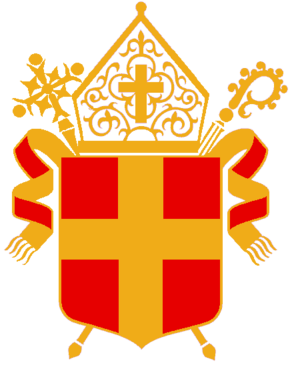
The 19th century coat of arms is based on that of the Archdiocese of Uppsala. It is blazoned Or on a cross Gules an open crown of the field and thus features a gold/yellow field with a red cross on which there is a gold/yellow crown.[15] The crown is called the victory crown of Christ, based on the royal crowns used in medieval times and corresponds in form to the crowns in the Swedish coat of arms and to that resting on the head of Saint Eric in the coat of arms of Stockholm.
Synodical structure
The Church adopted, at the time that it was still a state church, an administrative structure largely modelled after the state. Direct elections are held to the General Synod (Swedish: Kyrkomötet, The Church Assembly), and the diocesan and parish (Swedish: Församling) assemblies (and in some cases, confederation of parishes (Swedish: kyrklig samfällighet, 'church association') assemblies and directly elected parish councils). The electoral system is the same as used in the Swedish parliamentary or municipal elections (see Elections in Sweden). To vote in the Church general elections, one must be member of the Church of Sweden, at minimum 16 years of age, and nationally registered as living in Sweden.
The groups that take part in the elections are called nominating groups (Swedish: nomineringsgrupper). In some cases the nationwide political parties take part in the elections, such as the Social Democrats and the Centre Party. After the formal separation of Church of Sweden from the State of Sweden, the growing tendency in the elections is towards independent parties forming for candidature, either based on a political conviction, for example Folkpartister i Svenska kyrkan founded by Liberal People's Party members, or a pure church party such as the political independents' Partipolitiskt obundna i Svenska kyrkan (POSK) and Frimodig kyrka.
Ordained ministry
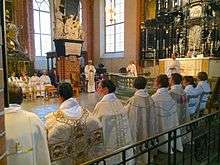
The Church of Sweden maintains the historic threefold ministry of bishops, priests, and deacons, and has approximately 5,000 ordained clergy in total.[16]
It practices direct ordination, also called ordination per saltum (literally, ordination by a leap), in which candidates are directly ordained to the specific Order of ministry for which they have trained. This is an alternative approach to the sequential ordination of other historic churches (including the Anglican, Orthodox, and Roman Catholic churches) in which candidates must be ordained in the strict sequence of deacon, then priest, then bishop. A Church of Sweden priest will be ordained directly to that office, without any previous ordination as a deacon. In the history of Holy Orders direct ordination seems to have been commonplace in the Church before the fourth century,[17][18] whilst the two systems (direct ordination and sequential ordination) seem to have co-existed in different places, until the eleventh century, when sequential ordination became universally normal and requisite,[18] under Pope Gregory VII (1073-1085).
After the Reformation, the Swedish Church seems to have practiced variously both direct ordination and sequential ordination. Although direct ordination was more widespread, and became normative, the practice of sequential ordination is attested in the seventeenth century Swedish Church. Bishop Johannes Rudbeckius (1619-1646) habitually ordained men to the diaconate in advance of ordaining them to the priesthood,[19] and this was said by Archbishop Johannes Lenaeus of Uppsala (in 1653) to be usual Church of Sweden practice.[20]:415
In the Evangelical Lutheran churches, including the Church of Sweden, ministerial function is indicated by the usual vestments of western tradition, including the stole, worn straight or crossed by priests, and diagonally by deacons. However, whereas in Roman Catholic or Anglican ordinations the candidates for priesthood will already be wearing the diagonal deacon's stole, in the Church of Sweden candidates for both diaconate and priesthood are unordained at the start of the service. Dr Tiit Pädam, of Uppsala University and a Swedish-based priest of the Estonian Evangelical Lutheran Church writes: "At the beginning of the [Evangelical Lutheran] ordination service, the candidates are dressed in white albs and no one wears a stole at the beginning of the rite. In this way the churches express a significant aspect of their understanding of ordination. The white alb, used both by the ordinands to the diaconate as well as to the priesthood, is a sign that the ordination is a new beginning, rooted in the priesthood of all the baptised."[21]:276
The Church of Sweden employs full-time deacons to staff its extensive outreach and social welfare diakonia programme. Whilst deacons have the traditional liturgical role (and vesture) in the Swedish Church, their principal focus of work is outside the parish community, working in welfare roles. Nonetheless, deacons are attached to local parishes, and so connected with church communities, and with a parish priest. In common with other western rite churches, the clergy of the Church of Sweden wear clerical shirts which are black for priests and purple for bishops. Unlike other denominations, however, the Church of Sweden officially promotes green clerical shirts for its ordained deacons, as a further distinctive sign of their ministry.[22]
Dioceses and bishops
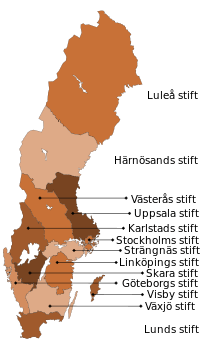
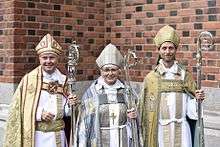
The Church of Sweden is divided into thirteen dioceses (Swedish: stift), each with a bishop and cathedral chapter (Swedish: domkapitel). A bishop is elected by priests, deacons and some laity in the diocese and is the chairman of the cathedral chapter. Priest and deacon members of a cathedral chapter are elected by priests and deacons in the diocese and its lay members by stiftsfullmäktige, a body elected by church members.[23]
A diocese is divided into "contracts" kontrakt (deaneries), each with a kontraktsprost (provost), as the leader. Deaneries with a diocesan cathedral are called domprosteri. Titular provosts can also sometimes be appointed, in Swedish called prost or titulärprost. The dean and head minister of a cathedral is called domprost, "cathedral dean" or "cathedral provost", and is a member of the cathedral chapter as its vice chairman.[23]
At the parish level a parish is called församling.[23] A more archaic term for a parish in Swedish is socken, which was used both in the registry and in the church administration. After the municipal reforms in 1862 the latter usage officially was replaced with församling, a term somewhat meaning "congregation", originally and still used for the Lutheran territorial and nonterritorial congregations in cities and also for other religious congregations. One or several parishes are included in a pastorat[23][24] with a head minister or vicar called kyrkoherde[23] (literally "church shepherd") and sometimes other assistant priests called komminister (minister). At a cathedral an assistant minister is called domkyrkosyssloman.
In addition to the 13 dioceses, the Church of Sweden Abroad (Swedish: Svenska kyrkan i utlandet - SKUT) maintains more than 40 overseas parishes. Originally a collection of overseas churches under the direction of a committee of the General Synod, SKUT was remodelled from 1 January 2012 with a quasi-diocesan structure. Under this remodelling it gained a governing Council, constituent seats on the General Synod of the Church of Sweden (like the 13 mainland dioceses), and for the first time full-time deacons to provide a programme of social welfare alongside the work of priests and lay workers.[25]:20 However, SKUT does not have its own bishop, and is placed under the episcopal oversight of the Bishop of Visby.
| Diocese | Seat | Cathedral | Founded | Current bishop |
|---|---|---|---|---|
| Archdiocese of Uppsala | Uppsala | Uppsala Cathedral | 1123 | Antje Jackelén (Archbishop) Karin Johannesson (Bishop) |
| Diocese of Skara | Skara | Skara Cathedral | 1014 | Åke Bonnier |
| Diocese of Lund | Lund | Lund Cathedral | 1048 | Johan Tyrberg |
| Diocese of Linköping | Linköping | Linköping Cathedral | 1100 | Martin Modéus |
| Diocese of Strängnäs | Strängnäs | Strängnäs Cathedral | 1129 | Johan Dalman |
| Diocese of Växjö | Växjö | Växjö Cathedral | 1165 | Fredrik Modéus |
| Diocese of Västerås | Västerås | Västerås Cathedral | 12th century | Mikael Mogren |
| Diocese of Visby | Visby | Visby Cathedral | 1572 | Thomas Petersson |
| Diocese of Karlstad | Karlstad | Karlstad Cathedral | 1581 | Sören Dalevi |
| Diocese of Gothenburg | Gothenburg | Gothenburg Cathedral | 1620 | Susanne Rappmann |
| Diocese of Härnösand | Härnösand | Härnösand Cathedral | 1647 | Eva Nordung Byström |
| Diocese of Luleå | Luleå | Luleå Cathedral | 1904 | Åsa Nyström |
| Diocese of Stockholm | Stockholm | Stockholm Cathedral | 1942 | Andreas Holmberg |
The Diocese of Kalmar existed as superintendentia 1603–1678 and as a diocese between 1678–1915 when it was merged with the Diocese of Växjö. Another diocese which no longer exists is the Diocese of Mariestad which existed as superintendentia between 1580–1646 and was replaced by the Diocese of Karlstad.
The dioceses of Uppsala, Strängnäs, Västerås, Skara, Linköping, Växjö and the now Finnish diocese of Turku, are the original seven Swedish dioceses, dating from the Middle Ages. The rest have come into existence after that time and the Swedish reformation in the 16th century. The Diocese of Lund was founded in 1060, became an archdiocese in 1104 and lay in Denmark. The Province of Lund consisted of Denmark, Sweden and Finland throughout the Middle Ages (originally also Norway and Iceland), although Uppsala had their own subordinate ecclesiastical province and archbishop from 1164.
Monasteries and convents
The Church of Sweden has several monastic communities.
- The Sisters of the Holy Paraclete (Helgeandssystrarna), who live in Alsike Convent.[26]
- The Brothers of the Holy Cross (Heliga korsets brödraskap), Benedictine monks who live at the Östanbäck Monastery in Sala, Västmanland.[27]
- The Sisters of St. Francis (Helige Franciskus systraskap), Franciscan nuns who live in Klaradals kloster in Sjövik.
- The Sisters of the Risen Saviour (Uppståndne frälsarens systraskap) who live in Överselö klostergård.
- The Daughters of Mary (Mariadöttrarna av Den Evangeliska Mariavägen) in Vallby.
- Linköpings kloster in Linköping, approved by the Bishop of Linköping in 2006, and inaugurated in 2014, a small contemplative and vegetarian convent, focused on climate issues;[28] it has links with the Anglican Society of Saint Margaret.[28]
Partner churches
Since 1994 the Church of Sweden has been part of the Porvoo Communion, bringing it into full Communion with the Anglican churches of the British Isles and the Iberian Peninsula, together with the other Lutheran churches of the Nordic nations and the Baltic states. In 1995 full communion was achieved with the Philippine Independent Church. Since 2015, the Church of Sweden has also been in full communion with the Episcopal Church of the United States.[29]
In 2016, the Church of Sweden reached full communion with the Old Catholic churches within the Union of Utrecht.[30]
See also
| Part of a series on the |
| Culture of Sweden |
|---|
 |
| History |
| People |
| Languages |
|
Mythology and folklore |
| Cuisine |
| Festivals |
| Art |
| Literature |
|
Music and performing arts |
|
Media
|
| Sport |
|
Monuments |
|
Symbols |
|
- Archbishop of Uppsala
- Church of Sweden Abroad
- List of Lutheran dioceses and archdioceses
- Church of Sweden Parishes
- Swedish churches in London
- List of the largest Protestant bodies
Other Nordic national Lutheran churches
References
Citations
- "Svenska kyrkan i siffror". Svenska kyrkan (in Swedish).
- Member churches The Lutheran World Federation
- "SFS 1998:1591", Riksdagen
- website Church of Sweden
- Wockner, Rex. "Lesbian bishop consecrated in Sweden". QX. QX Förlag AB. Retrieved 20 July 2014.
- Wendy Sloane (1995-10-04). "Sweden Snaps Strong Ties Between Church and State". The Christian Science Monitor. Retrieved 2016-01-15.
- "Liturgy and Worship" Archived April 22, 2010, at the Wayback Machine, Church of Sweden
- "Church of Sweden says yes to gay marriage". The Local: Sweden's News in English. 2009-10-22. Archived from the original on 2012-01-11. Retrieved 2012-06-03.
- Church of Sweden: Svenska kyrkans medlemsutveckling år 1972–2018 Svenska kyrkan
- Saint Helen of Skofde Archived 2008-10-14 at the Wayback Machine Patron Saints Index
- Encyclopædia Britannica Eleventh Edition, article Sweden
- "Sweden elects its first female archbishop, the German-born bishop of Lund – Fox News". Fox News Channel. 15 October 2013.
- Vår svenska stam på utländsk mark; Svenska öden och insatser i främmande land; I västerled, Amerikas förenta stater och Kanada, Ed. Axel Boëthius, Stockholm 1952, Volume I, pp. 92, 137, 273 & 276; for the whole section
- Gold is represented as yellow in non-metallic representations of coats of arms.
- Structure and numbers of clergy listed on the official website in English.
- Hallenbeck, Edwin (1996). The Orders of Ministry: Reflections on Direct Ordination (First ed.). North American Association for the Diaconate.
- "Direct Ordination". The Episcopal Church of the United States of America. Retrieved 19 February 2017.
- "Report of the Commission Appointed by the Archbishop of Canterbury, In Pursuance of Resolution 74 of the Lambeth Conference of 1908 on the Relation of the Anglican Communion to the Church of Sweden". The Young Churchman (1911), reproduced by Project Canterbury. Retrieved 19 February 2017.
- Whitelocke, Bulstrode (1772). A Journal of the Swedish ambassy in the years MDCLIII and MDCLIV from the Commonwealth of England, Scotland and Ireland : with an appendix of original papers, written by the ambassador, the Lord Commissioner Whitelocke (1772 republication ed.).
- Pädam, Tiit (2011). Ordination of Deacons in the Churches of the Porvoo Communion: A Comparative Investigation in Ecclesiology (First ed.). Kirjastus TP (Uppsala). ISBN 978-9949-21-785-4.
- See report Mobilise the Greenshirts!.
- Kyrkoordningen (in Swedish) (internal church regulations).
- A pastorat is a subdivision within the Church of Sweden. A pastorat includes one or several parishes. Similar to a Norwegian Prestegjeld.
- Anders Wejryd, Archbishop (2012). 2011 Review and financial summary for the Church of Sweden, national level (First ed.). Trossamfundet Svenska kyrkan.
- "Archived copy". Archived from the original on 2008-10-30. Retrieved 2008-06-08.CS1 maint: archived copy as title (link)
- "Archived copy". Archived from the original on 2008-09-21. Retrieved 2008-09-21.CS1 maint: archived copy as title (link)
- "Background". Linköpings kloster. Retrieved 29 February 2020.
- Referenced here.
- Referenced .
Sources
- Gustafsson, Berndt (1983) [1973]. Svensk kyrkohistoria. Handböcker i teologi (in Swedish) (6th ed.). Helsingborg: Plus Ultra. ISBN 91-970355-7-2. SELIBR 7791193.
